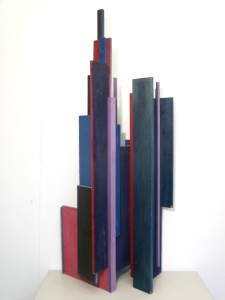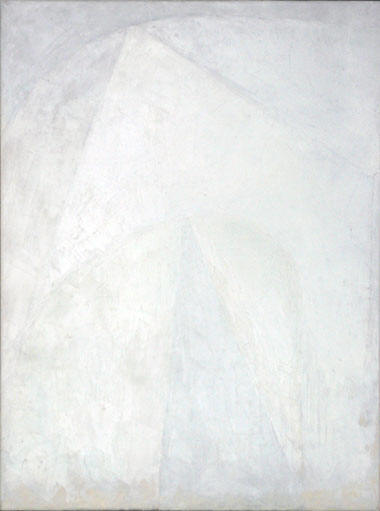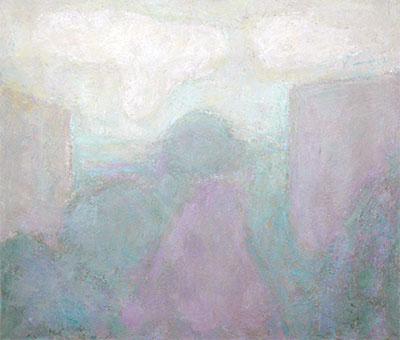|
Oleg Prokofiev: ‘From East to West’
31st March- 26th April 2014
 Between
the Lines Between
the Lines
by E.S.Jones
‘My father’s music gives me a
wave of some wonderful energy that brings to the surface a poetic or
artistic impulse… His was another art form but some details of his
music- his laconism- are near to me….’
Oleg Prokofiev, The Independent 1989
Oleg Prokofiev’s desire to find a
synthesis between painting and the plastic arts led him to a series
of works following a single line through loops and tangles. As the
son of the legendary composer Sergei Prokofiev, he had grown up in
the midst of creativity. Borrowing the musical idea of free
expression within a set pattern, Prokofiev chose his unusual colours
and forms, exactly as his father had used ‘wrong notes’ in his
compositions- unexpected shifts that would resonate long afterwards.
The leaping arpeggios of these sculptural works are a continuation
of themes already touched on by his post-impressionist paintings:
Form versus formlessness; the dynamics of creation and becoming; the
oscillation between order and the need to destroy it. Tempo and mood
is controlled through rigid lines as though the artist conducts an
orchestra; the meandering colours stretching and bending, keeping
strict time in shapes.
A trip to New York was the catalyst
for Prokofiev’s transition from painting to sculpture. After the
gentle European landscapes he had become accustomed to, the artist
was stunned by aggressive vertical lines of looming towers, sharp
skyscrapers and the hustle of a busy city. On returning to Europe he
immediately began to improvise the Manhattan skyline. His subsequent
‘stripe’ series could be made of ironed out twists of coloured glass
from the insides of marbles in shades of deep red, pale blue, olive
green and shell pinks. Bright corals and ultramarines flicker behind
watercolour glazes, sorting out the new intensities in his mind,
preparing the way for surprising three-dimensional works.
One day, back in his London studio,
Prokofiev stuck a strip of wood to canvas, instead of simply
painting another stripe. His next work happened to be a painted
relief, and after that he dispensed with the flat surface entirely.
He began fashioning tower blocks and stacked buildings from
ready-made planks and sticks, creating organic constructivist
sculptures. With his studio right by the Thames, he would scavenge
the city beach for driftwood and other washed up objects to use. The
boundaries between painting and sculpture were in constant flux as
he cut and assembled the wood, shaping the structures further with
paint. He resisted calling these ‘sculptures’, using the term only
according to strict definition, at a loss for a more satisfactory
label. Using found objects such as small squashed tins, broken chair
legs or pieces of machinery, he developed a magpie obsession over
the accidental treasures found on the street.
Notebooks full of labyrinthine
doodles show Prokofiev’s endless journeys across the paper,
attempting to pin down his ideas. Spiking, curly, twisted lines end
up in claws and eyes; there are glimpses of piano keys and harp
strings in the centre of the hectic swarms. He considered his
drawings to be only hints, the first step towards discovering the
line ‘in flesh’. Detailed studies fifteen years previously into
Ancient Indian art had also affected Prokofiev with its concept of
the plastic arts as the continuation of nature. He referred to these
creations as ‘coloured line in space’ hanging them across walls like
abstracts come alive to the touch.
Later on, as more and more sculptures
were created, his studio began to resemble an installation. He
arranged the work in heaps and stiff lines like soldiers, hanging
some from the ceiling, creating giant towers from the floor. During
this time he produced some 200 works, a whole cave of stalactites
and stalagmites that attempted to develop ideas and solve problems.
The finished pieces appear like solid music, energetic and original,
like weird insects wonkily perched on twigs. The eye wanders along
painted paths and is met with a little green cog for an earring, or
finely written gold poetry. Wearing bright plumes of reds and blues,
the works sit around like oddly angled birds of paradise. Each piece
marks significant stages of Prokofiev’s life, lucid and immediate, a
testimony to the artist’s irrepressible spirit- rooted in the belief
that the only reality is now.
Shades Of Pale
Paintings From Prokofiev’s ‘White Period’
by E.S Jones
‘It
all begins with an unclear but somehow obsessive visual idea.’
Intention and Realisation, Oleg Prokofiev
 Artist
Oleg Prokofiev was born in Paris in 1928, moving to the Soviet Union
at the age of seven with his parents and brother. The second son of
Spanish singer Lina Liubera and composer Sergei Prokofiev, he grew
up in the strange world of Stalinist Russia. In this hostile
environment he witnessed his father’s fame and later demise- and his
mother sentenced for eight years to a labour camp. Artist
Oleg Prokofiev was born in Paris in 1928, moving to the Soviet Union
at the age of seven with his parents and brother. The second son of
Spanish singer Lina Liubera and composer Sergei Prokofiev, he grew
up in the strange world of Stalinist Russia. In this hostile
environment he witnessed his father’s fame and later demise- and his
mother sentenced for eight years to a labour camp.
Studying at the Moscow School of Art at the age of fourteen,
Prokofiev disliked the Soviet ideal upheld by his teachers of 19th
century realistic Russian painting. He had started his studies as a
student of sculpture but longed to be a ‘pure’ painter like the
impressionists. When Prokofiev was seventeen he met the
post-impressionist painter Robert Falk, out of favour with the
authorities, who took him under his wing into a world of underground
art. Falk was a founder member of the Knave of Diamonds group and
his passion for Cezanne appealed to the young Prokofiev who stayed
under Falk’s tuition for three years. He learned the serious
discipline of building up a painting according to colour theory and
the detailed observation of nature. Both artists shared the belief
that art should be a reflection of the world as it appears, and a
taste for modernism.
|
|
The
exhibition is held alongside a sculpture
collection which features works by
Oleg Prokofiev, Graham High, Eleanor Cardozo,
Nicola Godden,
Richard L.Minns,
Andy Cheese,
Jamie McCartney,
Ian Edwards,
Gianfranco Meggiato,
Massimiliano Cacchiarelli Principi
and
Palolo Valdes. |
 home
about
artists
exhibitions press
contact
purchase
home
about
artists
exhibitions press
contact
purchase
 Artist
Oleg Prokofiev was born in Paris in 1928, moving to the Soviet Union
at the age of seven with his parents and brother. The second son of
Spanish singer Lina Liubera and composer Sergei Prokofiev, he grew
up in the strange world of Stalinist Russia. In this hostile
environment he witnessed his father’s fame and later demise- and his
mother sentenced for eight years to a labour camp.
Artist
Oleg Prokofiev was born in Paris in 1928, moving to the Soviet Union
at the age of seven with his parents and brother. The second son of
Spanish singer Lina Liubera and composer Sergei Prokofiev, he grew
up in the strange world of Stalinist Russia. In this hostile
environment he witnessed his father’s fame and later demise- and his
mother sentenced for eight years to a labour camp. This particularly volatile time in Russia formed a backdrop for
meeting Camilla Gray, a young English dancer and art historian who
had come to Moscow in 1961 to work on her book. The Russian
Experiment in Art was a revolutionary study into the history of
the Russian avant-garde, putting it in the context of pre and post
war society. Camilla brought elements of the sciences, philosophies
and modern culture together with the stories behind the brilliant
personalities who instigated them. Camilla’s triumph on publishing
her masterpiece in New York was short-lived: Due to the political
mood of the time the authorities made sure she would be refused
entry back into Russia, whilst Prokofiev was forced to remain.
This particularly volatile time in Russia formed a backdrop for
meeting Camilla Gray, a young English dancer and art historian who
had come to Moscow in 1961 to work on her book. The Russian
Experiment in Art was a revolutionary study into the history of
the Russian avant-garde, putting it in the context of pre and post
war society. Camilla brought elements of the sciences, philosophies
and modern culture together with the stories behind the brilliant
personalities who instigated them. Camilla’s triumph on publishing
her masterpiece in New York was short-lived: Due to the political
mood of the time the authorities made sure she would be refused
entry back into Russia, whilst Prokofiev was forced to remain.